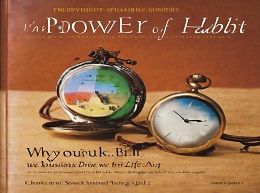The Power of Habit

"The Power of Habit: Why We Do What We Do in Life and Business" is a book written by Charles Duhigg. Published in 2012, the book explores the science behind habits, how they are formed, and how they can be changed. Here's a summary:
Key Themes:
-
The Habit Loop:
- Duhigg introduces the concept of the habit loop, which consists of a cue (trigger), routine (behavior), and reward. Understanding and manipulating this loop can help in forming or changing habits.
-
Keystone Habits:
- Keystone habits are small changes or habits that unintentionally lead to the development of other positive habits. Duhigg discusses the power of identifying and focusing on keystone habits for overall personal and professional development.
-
Cue, Routine, Reward:
- Duhigg explores how habits operate in everyday life and provides numerous examples, illustrating how individuals and organizations can analyze and modify the cue, routine, and reward components to create positive change.
-
Habits in Organizations:
- The book delves into the impact of habits on organizations, from corporate cultures to individual employee performance. It explains how habits can shape the success or failure of businesses.
Key Concepts:
-
The Golden Rule of Habit Change:
- Duhigg introduces the golden rule of habit change, which involves keeping the same cue and reward but changing the routine. By doing so, individuals can create new, positive habits.
-
Habits and Willpower:
- Duhigg discusses the relationship between habits and willpower, explaining that habits, once ingrained, become automatic behaviors that don't require significant willpower to execute.
-
Small Wins:
- The concept of "small wins" is highlighted, emphasizing that making small, achievable changes can lead to significant and positive transformations over time.
-
Social Habits:
- Duhigg explores the role of social habits and how social connections and influences impact individual and collective behaviors.
Impact:
-
Popular and Widely Read:
- "The Power of Habit" has become a popular and widely read book, appealing to a broad audience interested in personal development, psychology, and business.
-
Influence in Business and Leadership:
- The book has had a significant impact on the business and leadership communities, with its insights applied to organizational management and culture.
-
Application in Self-Help:
- The book's practical insights have made it a valuable resource in the self-help genre, offering readers actionable strategies for habit formation and change.
Practical Application:
-
Identifying Habit Loops:
- Readers are encouraged to identify the cues, routines, and rewards associated with their habits. This awareness is crucial for understanding and changing behavior.
-
Creating Keystone Habits:
- Duhigg suggests focusing on keystone habits—small changes that can have cascading positive effects on other aspects of life.
-
Harnessing the Power of Cravings:
- Understanding and harnessing the power of cravings is discussed, helping individuals redirect their habits toward more beneficial behaviors.
-
Changing Organizational Habits:
- The book provides insights into changing organizational habits, offering a framework for leaders to influence positive habits within their teams or companies.
"The Power of Habit" combines scientific research with engaging storytelling to provide readers with a deeper understanding of how habits work and how they can be harnessed for personal and professional growth. Its practical insights make it a valuable resource for those seeking to make positive changes in their lives.












